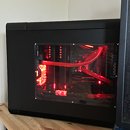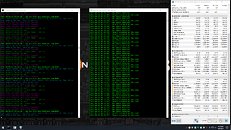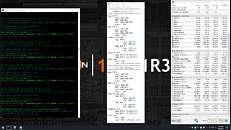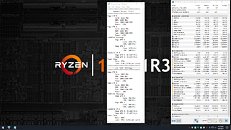Monday, September 4th 2017

RX Vega Achieves 43 MH/s @ 130 W in Ethereum Mining
AMD's RX Vega is more along the lines of an original computing card that was moved over to the consumer segment for gaming workloads than the other way around. Raja Koduri himself has said something along those lines (extrapolating a little more than what he can actually say), and that much can be gleaned with at least a modicum of confidence through AMD's market positioning and overall computing push. In the argument between gamers and miners, Raja Koduri didn't have all that much to say, but for AMD, a sale is a sale, and it would seem that after some tweaking, RX Vega graphics cards can achieve much increased levels of mining efficiency than their Polaris counterparts, further showing how Vega handles compute workloads much better - and more efficiently - than traditional gaming ones.Now granted, Vega's strength in mining tasks - Ethereum in particular - stems mainly from the card's usage of HBM2 memory, as well as a wide architecture with its 4096 stream processors. By setting the core clocks to 1000 MHz, the HBM2 memory clock at 1100 MHz, and power target at -24%, Reddit user S1L3N7_D3A7H was able to leverage Vega's strengths in Ethereum's PoW (Proof of Work) algorithm, achieving 43 MH/s with just 130 W of power (104 W of these for the core alone.) For comparison, tweaked RX 580 graphics cards usually deliver around 30 MH/s with 75 W core power, which amounts to around 115 W power draw per card. So Vega is achieving 43% more hash rate with a meager 13% increase in power consumption - a worthy trade-off if miners have ever seen one. This means that Vega 64 beats RX 580 cards in single node hashrate density, meaning that miners can pack more of these cards in a single system for a denser configuration with much increased performance over a similarly specced RX 580-based mining station. This was even achieved without AMD's special-purpose Beta mining driver, which has seen reports of graphical corruption and instability - the scenario could improve for miners even more with a stable release.Moreover, S1L3N7_D3A7H said he could probably achieve the same mining efficiency on a Vega 56, which isn't all that unbelievable - memory throughput is king in Ethereum mining, so HBm2 could still be leveraged in that graphics card. It seems that at least some of that initial Vega 64 stock went into some miner's hands, as expected. And with these news, I think we'd be forgiven for holding out to our hats in the expectation of increased Vega stock (at the original $499 for Vega 64 and $399 for Vega 56 MSRP) come October. Should the users' claims about RX Vega 56 efficiency be verified, and coeteris paribus in the mining algorithms landscape for the foreseeable future, then we can very much wait for respectable inventory until Navi enters the scene.
Source:
Reddit user @ S1L3N7_D3A7H






102 Comments on RX Vega Achieves 43 MH/s @ 130 W in Ethereum Mining
So you can make 50 MH/s using 2XRX570 with less power ...
Efforts to exploit the GPU for non-graphical applications have been underway since 2003. By using high-level shading languages such as DirectX, OpenGL and Cg, various data parallelalgorithms have been ported to the GPU. Problems such as protein folding, stock options pricing, SQL queries, and MRI reconstruction achieved remarkable performance speedups on the GPU. These early efforts that used graphics APIs for general purpose computing were known as GPGPU programs.
While the GPGPU model demonstrated great speedups, itfaced several drawbacks. First, itrequired the programmer to possess intimate knowledge of graphics APIs and GPUarchitecture. Second, problems had to be expressed in terms of vertex coordinates, texturesand shader programs, greatly increasing program complexity. Third, basic programming features such as random reads and writes to memory were not supported, greatly restricting the programming model. Lastly, the lack of double precision support (until recently) meantsome scientific applications could not be run on the GPU.
To address these problems, NVIDIA introduced two key technologies—the G80 unified graphics and compute architecture (first introduced in GeForce 8800®, Quadro FX 5600®, andTesla C870®GPUs), and CUDA, a software and hardware architecture that enabled the GPU to be programmed with a variety of high level programming languages. Together, these two technologies represented a new way of using the GPU. Instead of programming dedicated graphics units with graphics APIs, the programmer could now write C programs with CUDA extensions and target a general purpose, massively parallel processor. We called this new way
of GPU programming “GPU Computing”—it signified broader application support, widerprogramming language support, and a clear separation from the early “GPGPU” model ofprogramming.
So GPGPU is dead, long live GPU-Computing ... (addition for the archives)
Thats my only problem with the post... 130w is so easy to get if you know how to undervolt and clock
beep-beep, cluebus leaving...:laugh:
2. A totally Computing focused GPU, wich can game too, never will come close a pure Pixel-Monster, wich can Compute too, in Games on an efficient approach.
3. GCN just isn´t as modular as GeForce are.
some pictures what Nvidia can mix and match:
PDF from "Tesla G80", to Volta GeForce
www.file-upload.net/download-12692808/nvidia_SMX_GM104_GP100_GV100.pdf.html
and now remember what happened from HD7970 to Tonga to Fiji to Vega, sad huh?
I mean sure AMD is much better in another area, but just because it does as good or even a bit worse in some area does not mean it suddenly is worthless for that area....
Yet I get that sort of vibe from TPU as of late, and I dont know where its coming from.
Or have fanboys successfully overhyped Vega so that the outcome could only be disappointment so that we can now systematically set AMD aside for no real reason?
And Navi will only scale with Mhz like the architectures before, but we will NOT see IPC-Gains in Games.
And IF Navi will have MCMs with so then doubled or quadrupled Frontends the Driver alone has to do the sync and take down 4 CPU-Cores easy.
And this is wrong at least on several levels:
1) 103+43 ≠ 130
2) Software readings are inaccurate, especially when it comes to Vega
3) Card's power consumption is a lot more than just adding vCore and vRAM power
So, while it may somehow be possible to run Vega64 at 130W for mining, it is not possible at the current state to run 43.5MH/s at 130W....
...because science.
The most realistic approximation I can get off the top of my head is ~180W at 1000mV vCore with 1GHz GPU downclock, given that you don't attempt to overclock HBM.
We do have some Vega owners on TPU, who can probably verify my guesstimate.
Gamers abandoned AMD a long time ago, even when its cards were faster and cheaper.
AMD's strategy will make sense in the long term - full precision shaders are unnecessary for 90% of game tasks, so the shift to 16 bit shaders will be a boon both to compute centric tasks, and gaming on those tasks.
Until then (if your one of the 30% that buys a card that's faster than a 580), either you have other shit to do than just game, or really like AMD tech no matter what.
They've figured out that they can make a killing serving the mining market and not bother too much with satisfying gamers, so they've concentrated on creating great mining cards. You can even see this from Raja's comment, where Raevenlord says "in the argument between gamers and miners, Raja Koduri didn't have all that much to say, but for AMD, a sale is a sale". Quite. Sucks for us gamers, but I can't fault them for doing this as profit is the bottom line. I'd do exactly the same in their shoes. This strategy explains the use of that fast, expensive HBM on their cards, since it clearly helps with mining.
What we don't want is for NVIDIA to start doing the same, but I can see it happening...
What you speak of...AMD still commanded some 40% of the GPU market share among gamers. Technology products ebb and flow based on their technology so AMD naturally fell behind when they were blindsided by Maxwell. Even so, AMD can price their products to still be competitive against NVIDIA, and they do, which is why they still command a healthy market share. AMD was blindsided by GP102 again. What's AMD's response? Vega56: faster than GTX1070 by a large margin for about the same price. Their technology still is behind NVIDIA which shows in power consumption but, honestly, who cares? Most people make their purchase based on performance per dollar, not performance per watt.
AMD got knocked down again because NVIDIA outmaneuvered them again. They aren't out of the fight, not by a long shot.
Oh, and that RX Vega56 bitch slaps GP102 at compute. It's icing on the cake even if not particularly useful to gamers right now. There's still people happily playing new games on HD 7970 GHz cards. Radeon cards have untapped potential that is released with age. The same can't be said for GeForce. That raw compute power and architectural flexibility is the reason for that.
so because someone took the time to develop and optimise a mining client, which shows the real power these cards have, it makes them not for gaming....
Don't attribute a mining craze to anything AMD is doing right now, really, it is complete idiocy. The only thing mining is, is Vega's saving grace, because AMD gets to sell these at a decent price and not go the way the Fury did, price drop after price drop because nobody wants a loud AIO when the competitor has silent air. All AMD does is jump on the bandwagon out of pure necessity. There is no strategy here.
If you were able to purchase Vega 56 at MSRP, great. That's a pretty good gaming card, you'll be extremely satisfied - and you have objective reasons for being so.
If you purchased any Vega graphics card above MSRP, you may still feel great about your purchase, but objectively, it's almost certain that the comparable NVIDIA alternative is better in pure gaming/price/performance/power terms.
Meanwhile, if you're mining, you're actually tapping into Vega's potential and strengths, which sadly, and I would love to be wrong, isn't reflected in its gaming prowess.
That's why these aren't for gamers right now. Your mileage may vary with personal opinion, your favorite manufacturer, sure. But objectively, in a technical review, price/performance/power consumption graph like you see here at TPU, that doesn't stand.
RX Vega is about as gaming as a gaming card can get, the only problem is not even performance, but the supply.
So far out of the entire lineup of AMD's new cards we have:
- depleted polaris supply
- almost no Vega56/64 supply
- very-very few Frontier Edition cards in even fewer countries
- complete mystery about Radeon Instinct... (even Fiji-based MI8 is not out yet, and Vega-based MI25 was probably the first Vega to be announced)
A valid argument can be made it isnt for mining either as the ROI at its current pricing doesnt balance out with some other cards either.
See how that works... for both sides?Instead of taking your ball and going home with a snarky comment, how about you respond with why you feel that isnt true...its how forums should work.